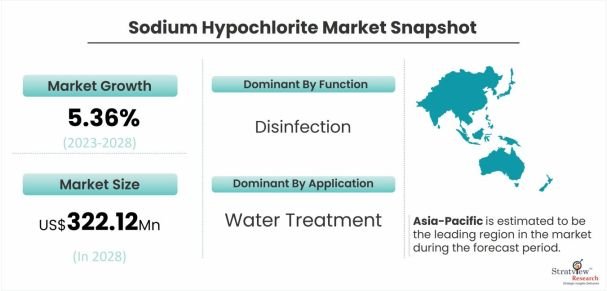Sodium Hypochlorite Market Trends: A Deep Dive into Industry Dynamics
The sodium hypochlorite market has seen steady growth over recent years, driven by its widespread use in disinfection, water treatment, and sanitation applications. As the demand for efficient cleaning agents and disinfectants rises, particularly in the aftermath of the COVID-19 pandemic, the market for sodium hypochlorite has gained significant momentum. This article delves into the key trends and dynamics shaping the sodium hypochlorite market, highlighting growth factors, challenges, and future opportunities.
According to Stratview Research, the sodium hypochlorite market was estimated at USD 234.84 million in 2022 and is likely to grow at a CAGR of 5.36% during 2023-2028 to reach USD 322.12 million in 2028.

Key Market Drivers
1. Increased Demand for Disinfection and Sanitation Sodium hypochlorite, commonly known as bleach, is a powerful disinfectant. Its use in sanitation and hygiene has expanded dramatically due to heightened public health awareness. During the COVID-19 pandemic, sodium hypochlorite-based solutions became essential in curbing the spread of the virus, especially in healthcare, public spaces, and households. This ongoing emphasis on cleanliness and disinfection continues to propel market growth, as businesses and governments maintain stringent hygiene standards.
2. Growing Use in Water Treatment Sodium hypochlorite plays a vital role in water purification and treatment. It is widely used to disinfect drinking water, wastewater, and industrial water systems, ensuring safe and clean water supplies. With global concerns about water scarcity and the increasing focus on sustainable water management, demand for sodium hypochlorite in water treatment facilities is expected to rise. The growth of urban populations and industrial activities further boosts its use in this critical sector.
3. Rising Awareness of Healthcare and Public Safety Beyond sanitation and water treatment, sodium hypochlorite is extensively used in healthcare settings for disinfecting medical equipment and surfaces. The healthcare sector’s continuous expansion, combined with stringent infection control protocols, makes it a key market for sodium hypochlorite. Furthermore, its application in public health initiatives, especially in developing regions, has significantly contributed to market growth.
Market Challenges
1. Environmental Concerns and Regulation While sodium hypochlorite is highly effective, its environmental impact presents a challenge. The chemical can release harmful byproducts, such as chlorine gas, which raises concerns about air quality and human safety. Regulatory agencies across various regions are imposing stricter guidelines on its usage, transportation, and disposal. Adhering to these regulations increases production costs, potentially limiting market growth.
2. Availability of Alternatives The market faces competition from alternative disinfectants and water treatment solutions, including hydrogen peroxide and chlorine dioxide, which are perceived as more environmentally friendly. This competition challenges sodium hypochlorite’s dominance, pushing manufacturers to innovate and improve the sustainability of their products.
Conclusion
The sodium hypochlorite market is characterized by robust growth driven by the increased focus on hygiene, sanitation, and water treatment. While the market faces challenges from regulatory pressures and competing products, the demand for reliable disinfection solutions remains high. As industries continue to innovate and seek more sustainable practices, the sodium hypochlorite market will likely continue to adapt, presenting both opportunities and challenges for stakeholders in the years ahead.